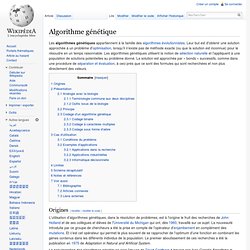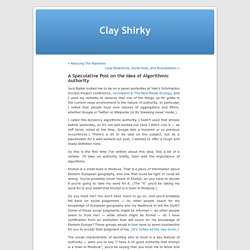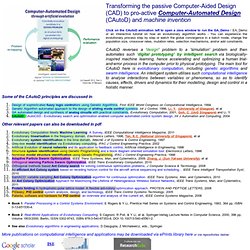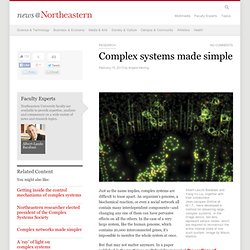

Les algorithmes génétiques - JM Alliot. Algorithme génétique. Un article de Wikipédia, l'encyclopédie libre.

Origines[modifier | modifier le code] La popularisation des algorithmes génétiques sera l'œuvre de David Goldberg à travers son livre Genetic Algorithms in Search, Optimization, and Machine Learning[1] (1989). Ce livre est encore édité aujourd'hui. En Europe, la première conférence sur ce type de sujet fut l'European Conference on Artificial Life en 1991 (elle a fêté ses 20 ans en 2011[2]), coorganisée par Francisco Varela et Paul Bourgine.
Un des premiers ouvrages à présenter en Français les algorithmes génétiques sera le livre[3] Intelligence Artificielle et Informatique Théorique qui lui consacrera un chapitre dès 1993. Présentation[modifier | modifier le code] [1001.1889] Cheating for Problem Solving: A Genetic Algorithm with Social Interactions. Kevin Slavin: How algorithms shape our world. » A Speculative Post on the Idea of Algorithmic Authority Clay Shirky. Jack Balkin invited me to be on a panel yesterday at Yale’s Information Society Project conference, Journalism & The New Media Ecology, and I used my remarks to observe that one of the things up for grabs in the current news environment is the nature of authority.

In particular, I noted that people trust new classes of aggregators and filters, whether Google or Twitter or Wikipedia (in its ‘breaking news’ mode.) Algorithmique. Optimisation et algorithmes génétiques - MAGNIN.plil.net. The Algorithmic Origins of Life - Sara Walker (SETI Talks) Laboratory for Web Algorithmics.
Click here for PhD projects in I. Some of the CAutoD principles are discussed in: Other relevant papers can also be downloaded in pdf: Book 1: Parallel Processing in a Control Systems Environment, E Rogers & Y Li, Prentice Hall Series on Systems and Control Engineering, 1993, 364 pp, ISBN 0-13-651530-4.

A smart-object recognition algorithm that doesn’t need humans. (Credit: BYU Photo) BYU engineer Dah-Jye Lee has created an algorithm that can accurately identify objects in images or video sequences — without human calibration.

“In most cases, people are in charge of deciding what features to focus on and they then write the algorithm based off that,” said Lee, a professor of electrical and computer engineering. “With our algorithm, we give it a set of images and let the computer decide which features are important.” Humans need not apply. Can Algorithms Find the Best Intelligence Analysts? The U.S intelligence community has a long history of blowing big calls — the fall of the Berlin Wall, Saddam’s WMD, 9/11.

But in each collective fail, there were individual analysts who got it right. Now, the spy agencies want a better way to sort the accurate from the unsound, by applying principles of mathematics to weigh and rank the input of different experts. Iarpa, the intelligence community’s way-out research arm, will host a one-day workshop on a new program, called Aggregative Contingent Estimation (ACE). The initiative follows Iarpa’s recent announcement of plans to create a computational model that can enhance human hypotheses and predictions, by catching inevitable biases and accounting for selective memory and stress. Network Science. Complex systems made simple. Albert-László Barabási and Yang-Yu Liu, together with their collaborator Jean-Jacques Slotine at M.I.T., have developed a method for observing large, complex systems.

In the image above, red dots represent sensor nodes, which are required to reconstruct the entire internal state of one such system. Image by Mauro Martino. Pinterest’s Founder: Algorithms Don’t Know What You Want. In 2012 the startup Pinterest became a peer of more established social sites by offering things that they didn’t—an attractive design, a focus on images rather than text, and a mostly female population of users.

On Pinterest, people use virtual “pinboards” to curate collections of images related to their hobbies and interests, discovering new items for their virtual hoards on the boards of friends and in the site’s personalized recommendations. Tom Simonite, MIT Technology Review’s senior IT editor, recently spoke with Ben Silbermann, Pinterest’s cofounder and CEO, about the company’s popularity. What was the need you were trying to fill when you created Pinterest? We started making Pinterest around 2009, when there was a lot of attention being paid to social services that were focused on real-time text-based feeds like Facebook and Twitter. We felt the things that we enjoyed doing in the real world were hard to express in that format. The site is established and popular.
The Rise of the Algorithmic Medium. The 10 Algorithms That Dominate Our World. A clustering algorithm based on swarm intelligence. The Top 10 Algorithms in Data Mining. Trust Is Not An Algorithm: Big Data Are Hot, But They Also Miss A Lot. Dictionary of Algorithms and Data Structures. This web site is hosted by the Software and Systems Division, Information Technology Laboratory, NIST. Development of this dictionary started in 1998 under the editorship of Paul E. Black. After 20 years, DADS needs to move. If you are interested in taking over DADS, please contact Paul Black. List of algorithms. Algorithme à estimation de distribution.
Un article de Wikipédia, l'encyclopédie libre.

Sorting Algorithms Are Mesmerising When Visualised. Please enable JavaScript to watch this video.

Sorting Algorithm Animations. Algorithms in Java, Parts 1-4, 3rd edition by Robert Sedgewick. Addison Wesley, 2003. Quicksort is Optimal by Robert Sedgewick and Jon Bentley, Knuthfest, Stanford University, January, 2002. Dual Pivot Quicksort: Code by Discussion. Bubble-sort with Hungarian (“Csángó”) folk dance YouTube video, created at Sapientia University, Tirgu Mures (Marosvásárhely), Romania. Select-sort with Gypsy folk dance YouTube video, created at Sapientia University, Tirgu Mures (Marosvásárhely), Romania. List of terms relating to algorithms and data structures. The NIST Dictionary of Algorithms and Data Structures is a reference work maintained by the U.S.

National Institute of Standards and Technology. It defines a large number of terms relating to algorithms and data structures. For algorithms and data structures not necessarily mentioned here, see list of algorithms and list of data structures. This list of terms was originally derived from the index of that document, and is in the public domain, as it was compiled by a Federal Government employee as part of a Federal Government work. Some of the terms defined are: Contourner les algorithmes. La lecture de la semaine nous vient de The Atlantic et du toujours pertinent Alexis Madrigal (@alexismadrigal), le titre de son article « Contre l’idée que les algorithmes sont objectifs ». « Quand un résultat provient d’un ordinateur sur la base de statistiques, cela doit être objectif, non ?
Inférence bayésienne. Un article de Wikipédia, l'encyclopédie libre. Le raisonnement bayésien s'intéresse aux cas où une proposition pourrait être vraie ou fausse, non pas en raison de son rapport logique à des axiomes tenus pour assurément vrais, mais selon des observations où subsiste une incertitude. Moteur d'inférence. Un article de Wikipédia, l'encyclopédie libre. Un moteur d'inférence (du verbe « inférer » qui signifie « déduire ») est un logiciel correspondant à un algorithme de simulation des raisonnements déductifs. Un moteur d'inférence permet aux systèmes experts de conduire des raisonnements logiques et de dériver des conclusions à partir d'une base de faits et d'une base de connaissances.
Les moteurs d'inférences peuvent implémenter : Bayesian Network - AI Depot. Statistical inference. In statistics, statistical inference is the process of drawing conclusions from data that are subject to random variation, for example, observational errors or sampling variation.[1] Initial requirements of such a system of procedures for inference and induction are that the system should produce reasonable answers when applied to well-defined situations and that it should be general enough to be applied across a range of situations.
Inferential statistics are used to test hypotheses and make estimations using sample data. The outcome of statistical inference may be an answer to the question "what should be done next? ", where this might be a decision about making further experiments or surveys, or about drawing a conclusion before implementing some organizational or governmental policy. The Algorithm: Idiom of Modern Science. By Bernard Chazelle hen the great Dane of 20th century physics, Niels Bohr, was not busy chewing on a juicy morsel of quantum mechanics, he was known to yap away witticisms worthy of Yogi Berra. The classic Bohrism “Prediction is difficult, especially about the future” alas came too late to save Lord Kelvin. Human Workers, Managed by an Algorithm.
Cours DEA J-M Fouet. How Algorithms and Editors Can Work Together to Burst the "Filter Bubble" The algorithms that surface content for us on Facebook and Google are miracles of modern programming. But Eli Pariser, author and chairman of the board at MoveOn.org, has concerns. In March, Pariser gave a popular TED talk about "filter bubbles" — the idea that when search and social networks only serve us content that we "like," we're not seeing content we need. The Human Algorithm: Redefining the Value of Data.
InShare246. Your Life is an Algorithm, Your Brain is an Operating System. Meet the algorithm that can learn “everything about anything” The most recent advances in artificial intelligence research are pretty staggering, thanks in part to the abundance of data available on the web. We’ve covered how deep learning is helping create self-teaching and highly accurate systems for tasks such as sentiment analysis and facial recognition, but there are also models that can solve geometry and algebra problems, predict whether a stack of dishes is likely to fall over and (from the team behind Google’s word2vec) understand entire paragraphs of text. Filtrage bayésien du spam. TinkerPop. Ken's Home Page. Algorithm Distinguishes Memes from Ordinary Information — The Physics arXiv Blog. Bayesia - Prenez les bonnes décisions.
About EPlex - Evolutionary Complexity Research Group at UCF. Learning Webs. Algorithmic culture. “Culture now has two audiences: people and machines” — Futurists’ Views. Clever Algorithms: Nature-Inspired Programming Recipes. Introduction to Algorithms. Bayes pour les nuls. Table Row Attributes 6. Algorithms bookmarks. BayesiaLab & Bayesian Networks. Portail:Algorithmique. Algorithm. Qu’est-ce qu’un algorithme ? La Clé du Médium Algorithmique. In the Olympics of Algorithms, a Russian Keeps Winning Gold. Algorithms. HyperNEAT User's Page. Algorithmia - Open Marketplace for Algorithms.